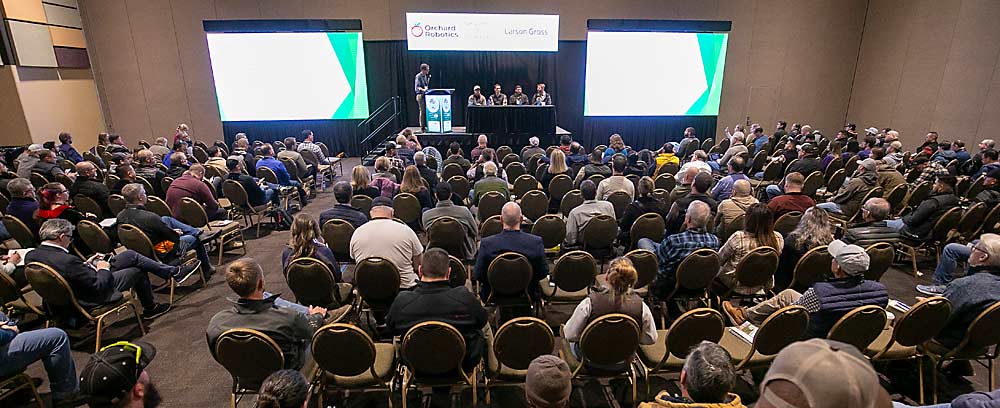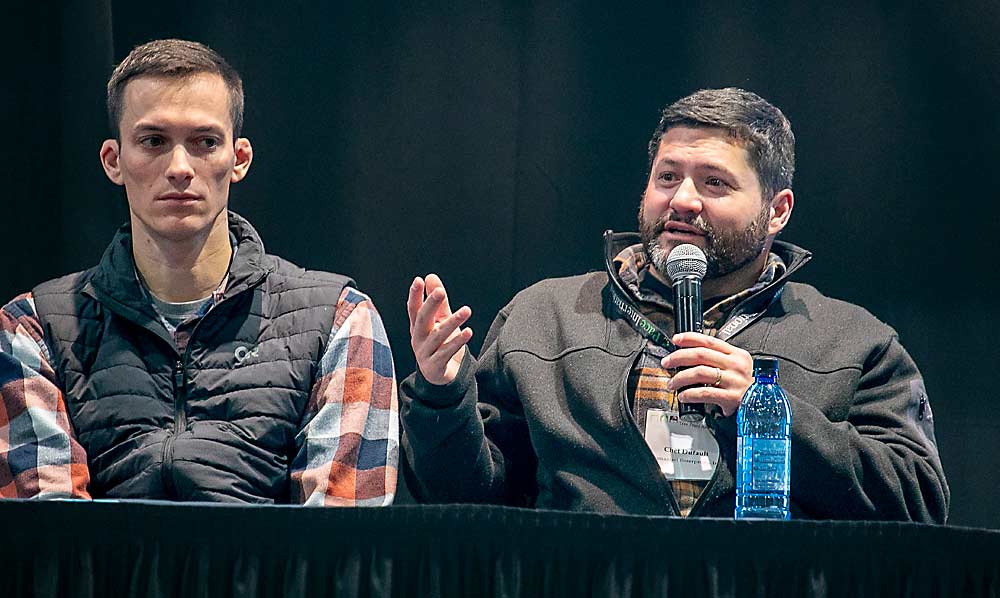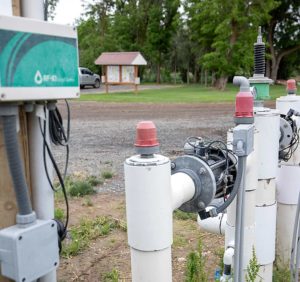
Accept some risk. Make sure you have the right infrastructure. Get to know how the technology works. And remember, people still matter.
Those were a few of the takeaways from a panel discussion on irrigation automation in December at the Washington State Tree Fruit Association Annual Meeting in Kennewick.
With Steve Mantle of innov8.ag moderating, grower panelists Paul Cathcart, Drew Washut, Chet Dufault and Gilbert Plath riffed on everything from how much they trust automatic sprinklers for frost control to how automation can mitigate overtime expenses.
All the growers use automated irrigation to some extent on their farms, and they all emphasized that the sensors and remote-controlled operation make employees more efficient and precise, not put them out of work.
“It’s never going to replace irrigators, you’ll still need people out there,” said Dufault of Emmanuel Enterprises, a family farm near Plymouth, Washington.
Historically, tree fruit orchards have let irrigation duties fall to a few specialists who roamed the blocks for 60–70 hours a week on four-wheelers. They knew the pipes and valves like the backs of their hands — where lines had been replaced, where clogs often happened and where coyotes liked to chew drip tape.
“If they get hit by a bus, so to speak, you’re in a world of hurt,” Mantle said.
Automated tools driven by sensors can help document that institutional knowledge for the rest of the farm, the panelists said.
Dufault uses a Phytech system. He previously irrigated based on evapotranspiration readings from the closest AgWeatherNet station, doing the math himself. Now sensors drive the decisions, changing how early he starts irrigating, and how much. For the most part, he bases decisions off the previous week. He uses less water overall.
Dufault would rather his trained irrigators troubleshoot, fix problems and establish ground truth for the system, not turn valves on and off. About 50 percent of his ranches are automated, he said.

Automated tools can be used even by irrigators who don’t consider themselves tech-savvy, said Cathcart, an area manager for Chiawana Orchards. They improve communication between the orchard manager and the irrigators, too, so that plans are executed correctly.
“Just give your workers the benefit of the doubt that they can do it, and they likely will be able to do it,” he said.
His farms use Phytech sensors for information but not yet for automated activation. He schedules by evapotranspiration readings.
Overtime requirements, which mandate time-and-a-half pay after 40 hours in Washington, force farms to split up irrigation duties, said Plath, an orchard manager and leader of a technology team at Washington Fruit and Produce Co. Data from automated systems improves communication between those irrigators and ranch managers, and it helps ensure plans are carried out accurately.
Washington Fruit has a range of irrigation technologies, Plath said. Most orchards have soil moisture sensors that inform spreadsheet-based decisions. Some orchards are fully automated with sensors from Phytech and remote control equipment from WiseConn Engineering, with everything controlled by smartphone.
Even with sensors and automation, irrigators and ranch managers still must discuss the data, including when and where water is needed and at what depth, said Washut, a process engineer for Allan Bros.
“It’s just that constant conversation and knowing the blocks,” he said.
Allan Bros. uses a WiseConn system to control its valves and its pump, which is equipped with a variable frequency drive that adjusts flow and pressure to demand. Sensors inform how much water the trees need and whether it needs to be pushed deep or kept closer to surface. Washut also likes a feature from SWAN Systems that will overlay NDVI maps of the same block from different days — say a date one year apart — and show changes in vegetative growth in different colors, which could reflect changes in water uptake.
Managing the technology transition can be tough, the panelists said. Automated systems require expensive solenoid valves and pumps with a variable frequency drive. Rootstock selections must be right, too. The best time to automate is in the planting of new orchards, they said.
The panelists also discussed how automation can better handle erratic climate changes, because the systems can be tied to the sensing of air or fruit surface temperatures. Again, overtime was part of the concern. Heat waves mean more work and more hours for irrigators; sensor-based automation can mitigate that.
It comes in handy for frost, too, triggering undercanopy sprinklers automatically tied to temperature readings.
However, Cathcart said he doesn’t quite trust automation for frost control, yet. The stakes are too high. Maybe in a few years, he said.
Remote control of pumps and valves lets irrigators sleep an extra 30 minutes, and they can turn on water before they even arrive on a cold morning, Washut said.
“That’s definitely helped us save some labor hours,” Washut said.
—by Ross Courtney







Leave A Comment